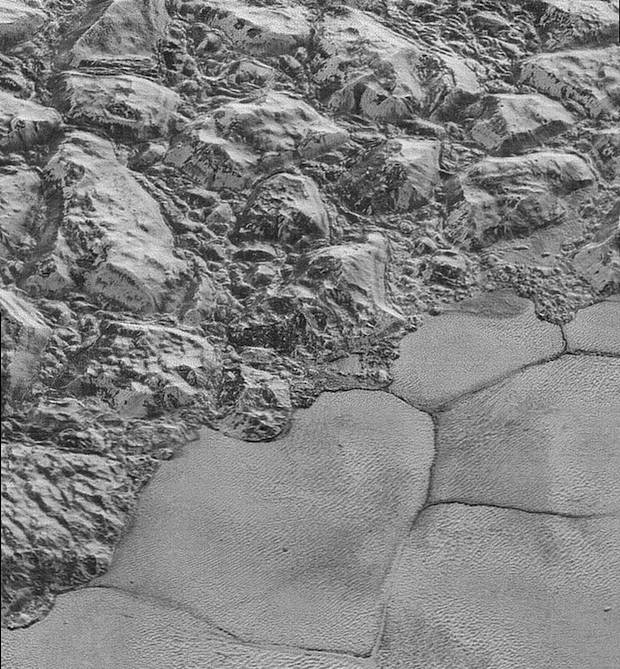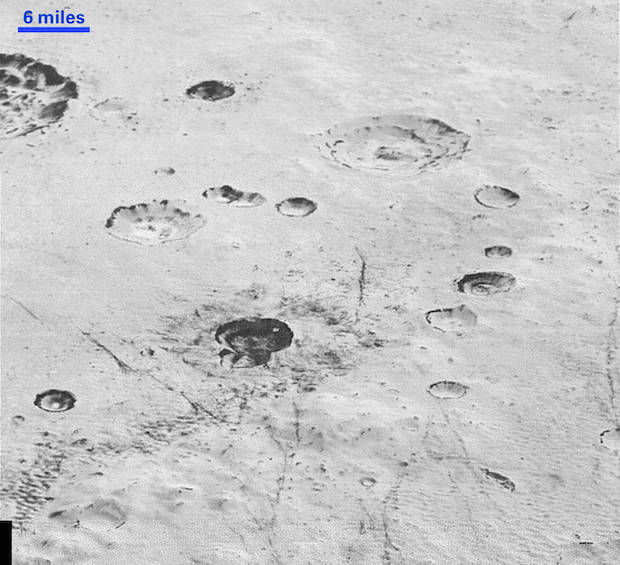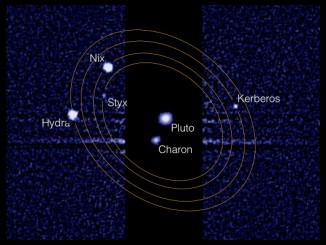
Scientists are marveling at some of the best views of Pluto recorded by the New Horizons spacecraft during its July 14 flyby of the unexplored icy dwarf in a set of photos released Friday showing Pluto’s icy, rugged topography in eye-popping detail.
The imagery from New Horizons’ telescopic camera — the Long Range Reconnaissance Imager — was taken when the probe was just 10,000 miles (17,000 kilometers) from Pluto, about 15 minutes before its closest approach on the first-ever encounter with the king of the Kuiper Belt.
“These new images give us a breathtaking, super-high resolution window into Pluto’s geology,” said Alan Stern, New Horizons principal investigator from the Southwest Research Institute in Boulder, Colorado. “Nothing of this quality was available for Venus or Mars until decades after their first flybys; yet at Pluto we’re there already — down among the craters, mountains and ice fields — less than five months after flyby! The science we can do with these images is simply unbelievable.”
Stern told Spaceflight Now the images released Friday are some of the highest-resolution images from the Pluto encounter, but there are more still stored inside the probe’s computer for future downlinks.
The latest images reveal features on Pluto’s surface less than half the size of a city block — as small as about 250 feet (77 meters) — as New Horizons’ LORRI camera scanned across a swath hundreds of miles long and 50 miles (80 kilometers) wide, NASA said in a press release.
Check out the full-resolution version of the Pluto image scan.
The strip starts at Pluto’s horizon, with mountainous lumps contrasted against the blackness of space, and across a crater field before reaching a ragged stretch of terrain named the al-Idrisi mountains. Geologists believe the mountains are made of water ice, which has the strength of rock at Pluto’s frigid temperatures.
“Impact craters are nature’s drill rigs, and the new, highest-resolution pictures of the bigger craters seem to show that Pluto’s icy crust, at least in places, is distinctly layered,” said William McKinnon, deputy lead of the New Horizons Geology, Geophysics and Imaging team, from Washington University in St. Louis. “Looking into Pluto’s depths is looking back into geologic time, which will help us piece together Pluto’s geological history.”

The high-resolution imagery also reveals finer details of a stark shoreline where the mountains intersect with a vast plain of frozen nitrogen, carbon monoxide and methane informally named Sputnik Planum, which appears broken into blocks that could be floating atop a liquid sea.
“The mountains bordering Sputnik Planum are absolutely stunning at this resolution,” said John Spencer, a New Horizons science team member from the Southwest Research Institute. “The new details revealed here, particularly the crumpled ridges in the rubbly material surrounding several of the mountains, reinforce our earlier impression that the mountains are huge ice blocks that have been jostled and tumbled and somehow transported to their present locations.”
Alex Parker, a member of the New Horizons science team from the Southwest Research Institute, shared his excitement on Twitter.
Mountains and sea both cast in ice. A frigid surf lapping at the shoreline with vast and deliberate slowness. #Pluto pic.twitter.com/UfyilkXXZ3
— Alex Parker (@Alex_Parker) December 4, 2015
Planetary scientist David Grinspoon also chimed in.
Holy Wow!! New, closest pictures of #Pluto reveal mountainous shoreline in stunning detail! https://t.co/eXDDIfMLwN pic.twitter.com/lpTeQBvB22 — David Grinspoon (@DrFunkySpoon) December 4, 2015
Since its July flyby, New Horizons has radioed scientists with compressed imagery, raw spectral and plasma data, and wide-angle snapshots of Pluto. Now the juiciest pictures, at least in resolution, are coming back to Earth.
“These close-up images, showing the diversity of terrain on Pluto, demonstrate the power of our robotic planetary explorers to return intriguing data to scientists back here on planet Earth,” said John Grunsfeld, former astronaut and associate administrator for NASA’s science mission directorate. “New Horizons thrilled us during the July flyby with the first close images of Pluto, and as the spacecraft transmits the treasure trove of images in its onboard memory back to us, we continue to be amazed by what we see.”
Email the author.
Follow Stephen Clark on Twitter: @StephenClark1.



